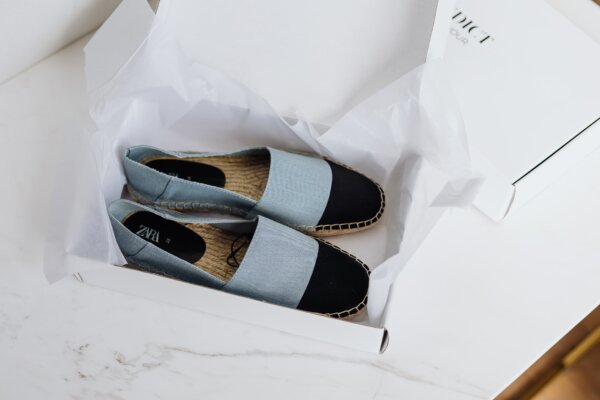
How To Design A Post-Purchase Experience That Creates Raving Fans
Most brands think optimization ends when the customer makes a purchase. But the post-purchase experience is an opportunity so big you can’t afford to ignore it.
Special Note: This article was inspired by an episode of our podcast, Drive & Convert. We go into much more detail here than we did on the show, but you might enjoy listening to the original conversation and subscribing to receive future episodes.
When elite marathoners cross the finish line, they don’t high-five the best sign holder (“Remember, you paid for this!”), wipe their brow, and chug a self-congratulatory beer.
Astoundingly, many of these best-of-the-best runners keep running. They have an entire cool-down process that starts just minutes after they cross the finish line, and they have that process for several reasons:
- Nearterm, they know plopping down down feels good for the first 30 seconds, but it only leads to a jaw-grinding level of soreness over the next 24 hours
- Longterm, a cooldown helps the athlete recover quickly for their next race; how they treat themselves 24 hours after finishing has a big impact on their next performance
Sure, they may grab a frothy pint later (nothing wrong with that!) — but not until they’ve set themselves up for continued success. While novice runners promptly collapse at the finish line, the best see it through a cool down.
Unfortunately, many ecommerce store owners take the novice approach; they run a marathon getting customers to purchase and fall on their face at the order-confirmed finish line. This is understandable — it’s hard work earning a first-time sale!
But, like the less experienced runners who skip post-race recovery, that collapse is also short-sighted. It leads to plenty of painful aches, such as the squeeze you feel when traffic dries up or ad prices jump.
There’s a better option:
Savvy store owners, like the elite marathons, know what they do immediately after a first purchase has a big impact on performance — boosting metrics like average order value, customer lifetime value, and overall store revenue.
What is the post-purchase experience?
The most useful definition for post-purchase customer experience is the activities, messages, and brand interactions that a customer experiences after purchasing a product or service from you.
This typically includes communication elements (Ex: email and SMS messages) as well as physical elements (Ex: unboxing) and behavior-based elements (Ex: customer service conversations). This guide gives you a step-by-step playbook for building a “best in class” post-purchase experience that will accelerate your business growth.
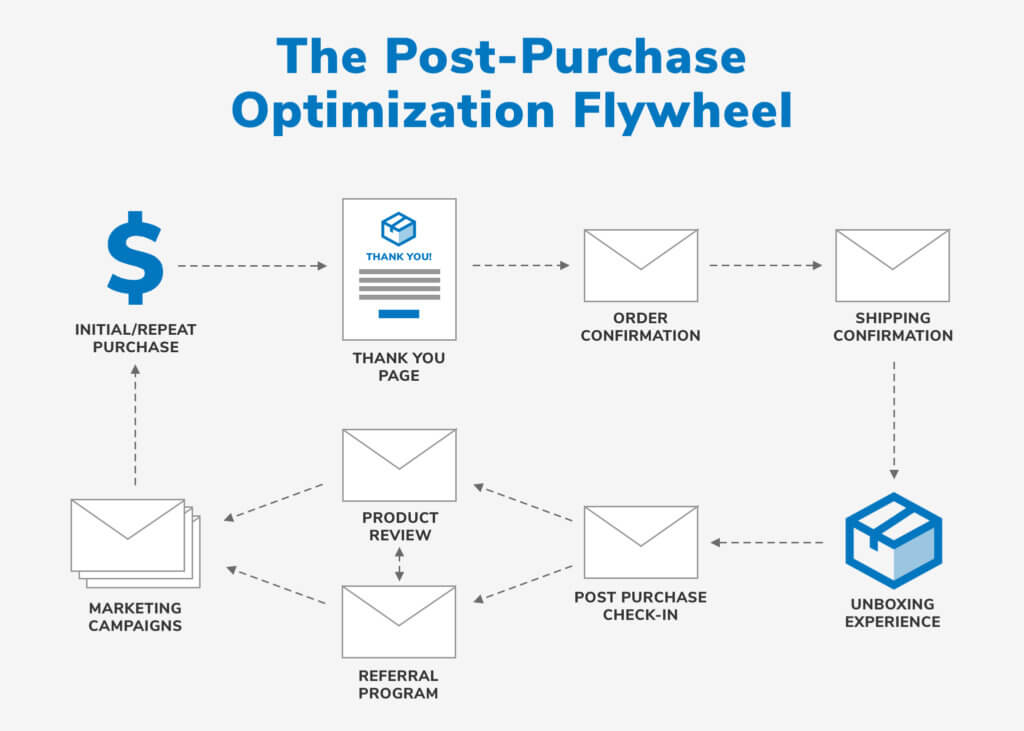
This journey has several points, and optimizing each one will create a compounding effect. The more you improve the post-purchase experience and prime repeat purchases, the more dramatically you can accelerate your business growth by increasing customer lifetime value and lifting overall revenue (more on how below).
Plus, this is something you can set up one time that will run continuously. Meaning, the long term gains are exponential compared to the time invested up front.
So, how exactly do you start optimizing and start benefiting?
This guide shows you.
We’ve broken out each piece of the post-purchase experience, outlined how you can improve it, and tied in what optimizing this journey can do for your brand.
Here’s what’s ahead:
- Why post-purchase is a huge missed opportunity
- Turning a simple “thank you” into more revenue
- The six emails of the post-purchase experience
- Four key metrics you can impact
Why post-purchase experience and optimization is a huge missed opportunity
Profitwell looked at just under 700 subscription companies and discovered something a bit unsettling — the price of acquiring new customers is on the up-and-up.

Compared to five years ago, the costs of getting a new customer on board is up nearly 60%.
New customers, while crucial, take an increasingly enormous amount of time and energy. In contrast, it’s much easier to get existing customers to complete an additional purchase, and they often spend more money than new customers. The lauded Marketing Metrics textbook states existing customers are 60-70% likely to make a repeat purchase whereas new customers are 5-20% likely to make an initial purchase.
Additional research by Bain indicates that the longer a customer stays with you, the more their average order value increases with subsequent purchases. In apparel, a customer’s fifth purchase is 40% larger than the first, and repeat customers spend 67% more in months 31-36 with a brand than in month zero-to-six.
Our own data from July-September 2020 shows similar findings. When we looked at 13 ecommerce retailers in the home goods, shoes and clothing, and consumables sectors, we found repeat purchasers (who make at least two purchases):
- Account for 54.93% of overall revenue
- Account for 47.14% of overall transactions
- Have a 27.62% conversion rate compared to the 2.01% sitewide average
- Have an 57.87% higher average order value compared to first-time customers.
So, we’ve established that repeat customers are easier to convert and tend to be more valuable over time. You may be asking yourself, “well then, how do I get more repeat purchases?”
We reached out to Kristen LaFrance, the head of Shopify’s Resilient Retail series, for advice:
“In ecommerce, you don’t have the same face-to-face sales interaction that you would in a retail setting, so you have to take care of some of those steps post-purchase, when you finally have a direct line of communication with the customer.
So that period between when someone gives you their money and when they actually receive the product is critical for forming a strong relationship. Educate them, address their questions or concerns, get them excited to rip open that box when it hits their doorstep. That’s what makes the difference between an okay experience and a great one – and that’s what’s ultimately going to make the difference between an okay customer and a great one.”
In other words, the best way to increase repeat purchases is to deliver a world-class customer experience right after a customer makes their first purchase. You know, that time where you’re probably sending an order confirmation email, a shipment tracking email and…that’s about it?
The reason has to do with consumption patterns. “When someone initially makes their purchase,” Kurt Elster, Shopify Plus Expert at Ethercycle, told us, “they are very likely, in the very near future, to make another purchase. When we buy stuff, it kicks off consumption cycles.”
For example, you buy a phone and need a phone case. You buy running shoes and need a great outfit to hit the pavement in. That’s why Kurt advises, “As soon as someone makes a purchase from you — and maybe they even need to buy the same thing a second time — give them the opportunity, prompt them, give them the excuse.”
When Kurt says as soon as someone purchases, he means it.
The very first thing your customer sees post-purchase — that unassuming thank you page — is a great place to start laying the groundwork for the next purchase.
Turning a simple “thank you” into more revenue
Take a minute and think about where you upsell customers. If you’re like most brands, you do this throughout the purchase process (e.g. on the product page) as well as in cart.
Let’s pause right there. While upselling in cart sounds like a great idea, it’s probably killing your conversions.
The problem is, many brands assume online checkout works like brick-and-mortar checkout. Meaning, they stash high-margin add-ons — brand equivalents of candy bars or lottery tickets — near the online “counter” to encourage customers to buy just a few more things and improve that average order value.
But here’s the thing: online checkout isn’t like brick-and-mortar checkout.
- Storefronts can have 5min+ wait times: In a store, checkout line items are there because you’re waiting on the customer in front of you. You’re held up by a five-family tornado (“did we only grab 1 pack of diapers?!”) or the coupon lady (“the Kleenex should be two for $1.50”), and you need to kill time while you wait. So you browse the shelves 10 inches from your nose. Maybe you even give yourself a break of that KitKat and pay for the wrapper at the register (no judgement). Those shelves serve a distinct purpose; they’re there to capture your idle attention and reorient your perception of waiting.
- Online stores have zero wait time: But online, you’re not experiencing this wait time. There’s no one holding up the line ahead of you. You have one goal, and that’s to get through checkout as quickly and easily as possible. In this context, upsells may not be a welcome distraction. They’re not something to do while you wait; they’re roadblocks to a seamless checkout experience.
Keep in mind, customer experience drives conversion rates, so adding friction to the customer’s experience may also negatively impact conversion. Meaning when you upsell in cart and throw a roadblock in the checkout flow, you could actually hurt conversion rates.
So, what can you do instead?
The thank you page: a better place to upsell
Most brands neglect the small but mighty thank you page. Given 100% of customers visit this page, it’s a shame so many of them are plain, templated, or only convey bare-bones information. For example, Debenhams’s page below:
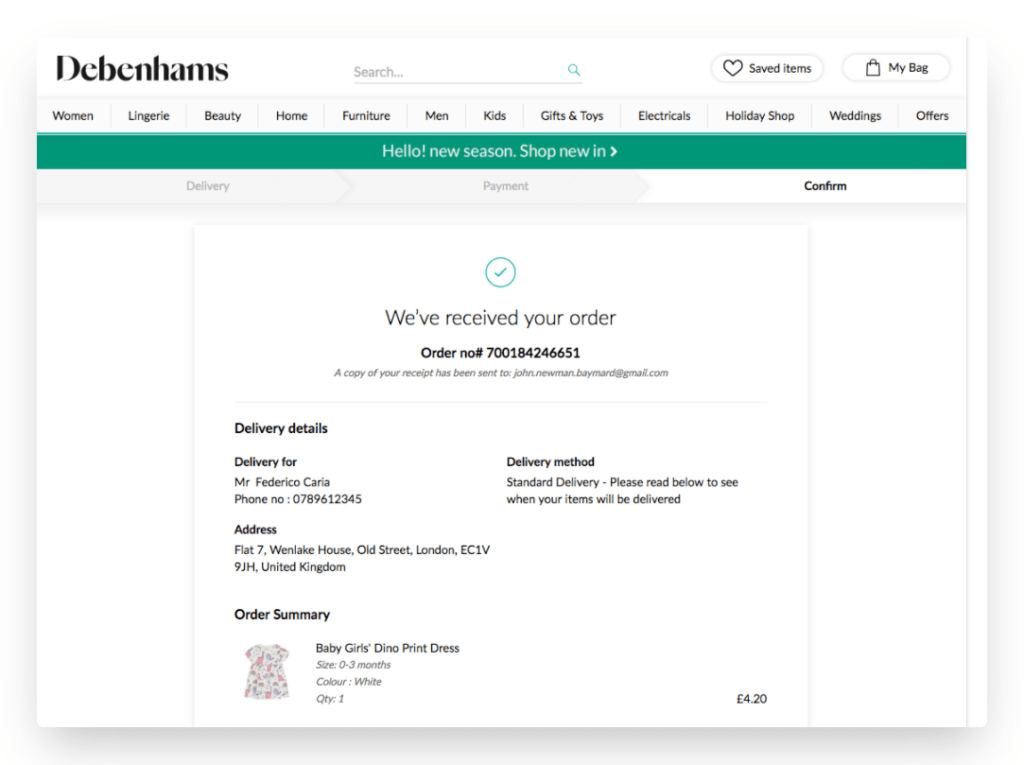
While confirming the customer’s order went through is absolutely a good idea, there’s so much more you can do here: alleviate post-purchase concerns, engage excited buyers and, yes, even upsell. In fact, upselling on your thank you page is much more effective than upselling in cart.
Jordan Gal, founder of Carthook, explains why: “Right after your customer buys something, they are at their most euphoric point, they are at peak happiness, and that is a good time to make an offer. And if you make that offer in a way that is beneficial to both parties, all of a sudden everyone wins. Your customer gets a complimentary product that enhances their experience and increases happiness or satisfaction, and you benefit from not only that additional happiness factor, but also a higher order value for almost no additional expense.”
Need a bit of data to back that up? Carthook has driven over $180 million in additional value for its merchants through post-purchase experience upsells.
So, the customer is already committed and primed for action when they reach your thank you page. Once they’re there, you can effectively upsell them a few different ways:
- Suggest bulk: Perhaps the customer could use four more light bulbs or two more pairs of socks. Especially for items the customer will buy over time anyways, a bulk option at a bundled rate or no extra shipping fees can be enticing.
- Pitch a subscription: If the item is something a customer uses and replenishes regularly (e.g. skincare products), suggest an automatic renewal option.
- Recommend complementary products: Remember what Kurt said about consumption cycles? If the customer purchased shoes, perhaps they need a pair of socks. Or if they purchased a king bedspread, perhaps they need new pillows and a bed skirt. Use your thank you page to suggest helpful related items the customers may have forgotten about.
For example, when you order a log splitter from Log Splitter Direct, they suggest earplugs and a branch cutter — handy items if you’re felling a dead oak out front. They do this via email, but you can list equivalent items for your brand on your thank you page:
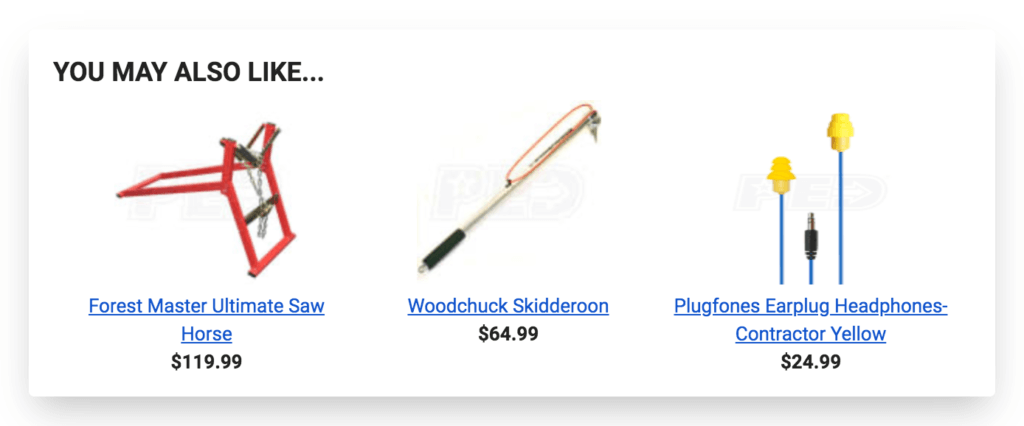
If you’re wondering, “yes, but how?”, the tool we mentioned above, Carthook, is one answer. Carthook allows you to show complementary products or subscriptions on your thank you page and prompt, “would you like to add these to your order?” Aside from offering additional value to customers, this helps you improve that average order value without adding friction to the checkout flow.
Of course, you don’t have to sell anything on your thank you page. There are plenty of other ways you can use it to reassure customers, build trust, and encourage loyalty.
What else can you do with your thank you page? Seven more optimizations
Remember, when your customer hits a thank you page, they’ve just made a purchase. They’re feeling a range of emotions from squirming excitement (“I cannot WAIT for this to arrive.”) to gripping anxiety (“oh crap, was that really the right decision?”).
There are plenty of ways you can engage these emotions to benefit both the customer and your brand.
Reassure anxious purchasers
If you’re anything like me, you feel a tinge of buyer’s remorse on a monthly basis. This is especially likely when purchasing a high-ticket item, such as top top-dollar tech.
However, there are at least three effective ways to alleviate that familiar pit-of-stomach feeling for customers: highlight the good causes the customer’s money goes towards, remind them of the awesome work environment their purchase supports, and showcase how happy other customers are.
All of these are great ways to say, “Hey, don’t worry, you’ve made a really great choice here!”:
- Highlight charities or causes you support: Morning Consult surveyed 2,200 US adults and found “56% of Americans are attentive to ethical and political matters relating to companies they purchase from – Democrats and younger generations notably more so than their peers.” If you participate in 1% For Good or regularly donate to certain causes or charities, let customers know! Show pictures from mission trips or images of the actual people and communities who benefit from your support (e.g. the image from 31Bbits below). It’s an honest way to help the customer feel better about their purchase.
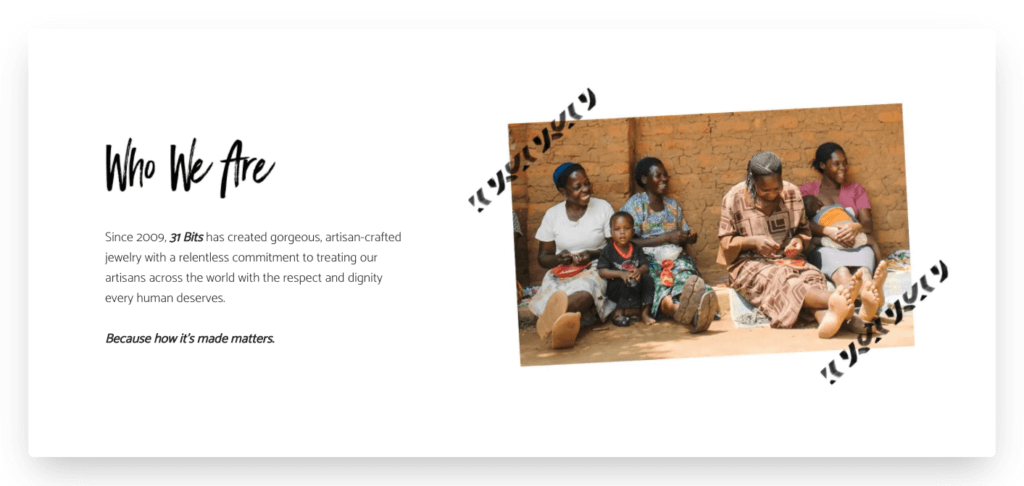
- Talk about your employees, team, and work environment: Likewise, if your brand provides an exceptional work environment or is a certified B Corp (like The Good!), tell customers. Show team pictures and founder messages. The same Morning Consult survey found more customers value employee treatment than whether your items are in stock when they make a purchase.
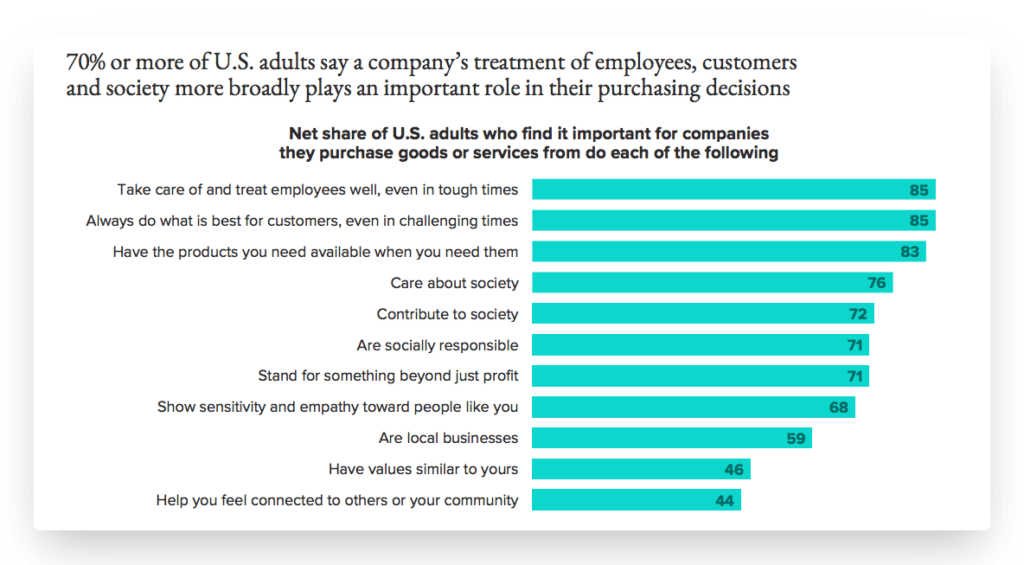
This logic extends to how you source your materials, too. For example, Allbirds does a good job of highlighting animal welfare. Messaging similar to this is great material for a thank you page.

- Showcase happy customers: Lastly, a great way to convince customers they’ve made a great purchase is to show them how happy other customers are with the same or similar purchase. Incorporate user-generated content such as reviews, testimonials, or social media posts to assuage any lingering concerns. As a bonus, this may encourage customers to share their own positive experience with you as well.
- Quantify the value: If your product is in the high-ticket category, consider showing the customer how they haven’t made a “for tomorrow” purchase, they’ve actually made a “for life” purchase. For example, they may have just spent $400 on shoes, but with that lifetime guarantee they’ll never need to buy dress shoes again. A similar tactic would be to demonstrate how a $1,000 laptop they’ll use for 8 years is $0.34 per day. Plus, if they use it to launch that business they’ve been dreaming about, it could double their money (or more!). Help customers visualize the value and not just the price tag.
Engage excited purchasers
For a customer that holy-moly-cannot-wait till their shipment arrives, there are a few ways you can stoke that fire.
- Promote original content: If you’ve produced something (blog posts, videos, etc) that will help a customer make use of their purchase, display it here! For example, if they just bought a bike, display content on bike riding, local trails, and how to join a cycling community. While this builds excitement, it also offers a form of reassurance — you’re helping customers see and believe they’ll use the purchase.
- Address FAQ: If you’ve created FAQ content, re-purpose that here. Identify the 3-5 most common post-purchase questions and answer them before the customer asks. Often this includes information about purchasing or using the product or how to handle returns. This can reduce your support team’s workload while equipping the customer to use the item they’re excited about.
- Include social share options: A small nudge may be all it takes for an excited customer to tell the world about their purchase. If so, social mentions will help you build brand awareness, attract more prospects to your site, and stockpile social proof. So give customers an easy, pre-written, and genuine way to brag about their purchase.
- Referral sharing: Did you know 92% of people trust recommendations from friends and family over any other type of advertising? Empower excited customers to share their purchase directly with friends through referrals. For example, give them a pre-written email they can send instantly and include an incentive both parties can use on their next purchase. (Remember to get creative! This doesn’t have to be 10% off.)
Figure out what on earth purchasers are feeling
If you’re not really sure what’s going through your customer’s head at this point (Excitement? Regret? Hunger?), the thank you page is a great place to ask them!
- Ask for feedback: Include a short survey that collects feedback on your customer’s buying experience. That sounds technical, but it doesn’t have to be complicated. Nick Disabato, founder of a Conversion Rate Optimization agency called Draft, explained, “you put a survey field on your thank you page or order status page of your store that asks, `How did you feel about your purchase today?’ And that’s it. That’s all you ask.” Disabato uses Hotjar for this and mentions you don’t need to add an incentive — folks will fill it out on their own.
Turns out, this is a surprisingly simple opportunity to identify friction in the customer experience (and remember, friction hurts conversions). Nick told us about several different scenarios he’s come across in his experiences.
The Guide To Optimizing Your Checkout And Post-Purchase Experience
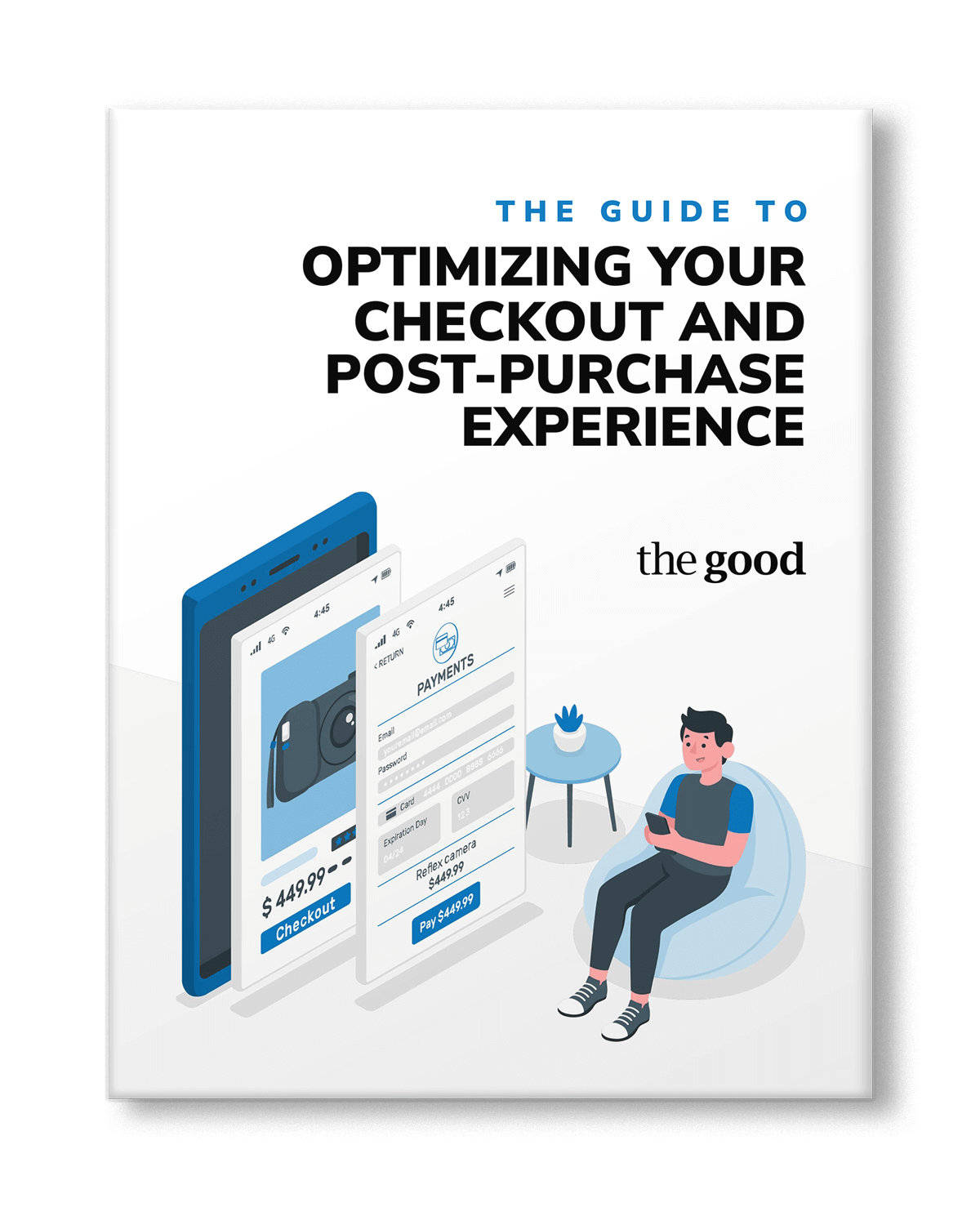
For example, customers might:
- Mention a bug. If so, you can fix it and improve conversions.
- Say they’re anxious and give a reason. This is a great way to identify and bust objections.
- Express they “hope it worked.” This is a great opportunity to follow up with a customer interview. Get them on the phone and ask what led them to think the checkout didn’t work? What were they expecting? And what would make it more clear?
This is seriously valuable information. Disabato emphasized, “You get a lot of insights and there are a lot of implications for it. Sometimes it’s cut and dry — this didn’t work, let’s fix it.” Other times, you uncover customer motivation that helps you optimize your product detail page. Either way, you’re figuring out what you don’t know and improving future customer experiences and conversions.
Whatever you opt for on your thank you page, remember to A/B test your changes. One ecommerce site may have a winning thank you page that consistently generates repeat customers, but that same page may not work as well for another brand with a different target audience. Don’t just copy your competitors — you’ve no idea how their page is working out for them.
Once you complete this step, you’ve dialed your thank you page, and reassured the customer they’re not only amazing — they’ve just made an amazing purchase.
What opportunities are next?
The six emails of the post-purchase experience
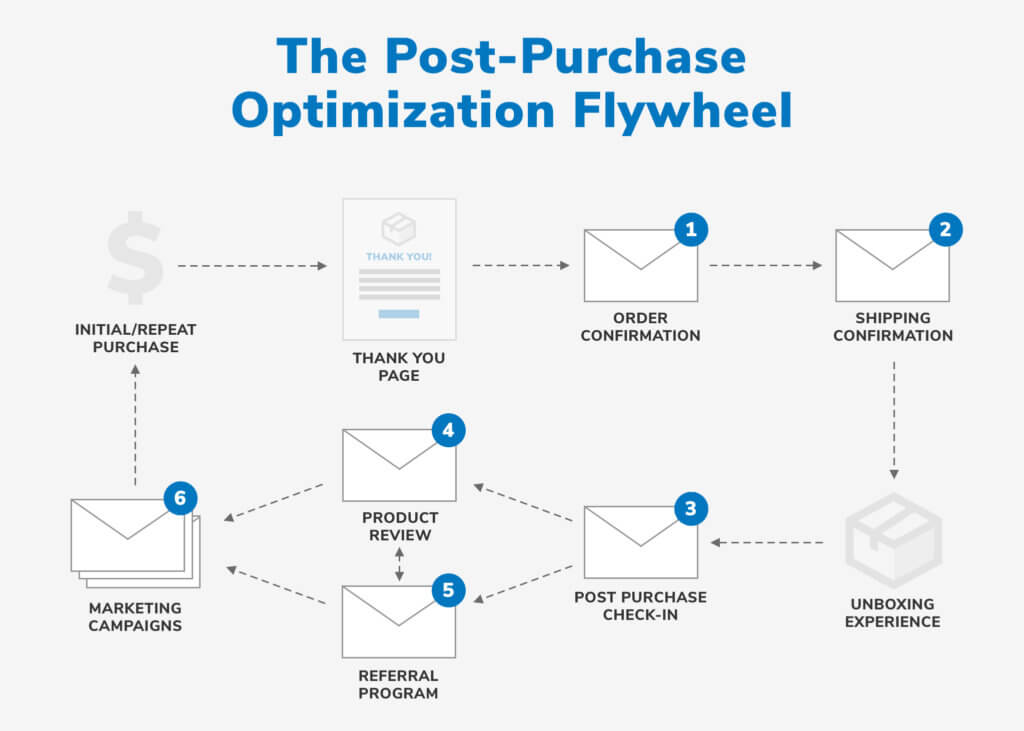
After the thank you page, the customer’s post-purchase experience moves off your site and into their inbox.
Narvar conducted a study of 1,543 shoppers between ages 21 and 65. They found 83% of the respondents expect regular updates about their purchases. Many brands give those updates, but the problem is, way too many of those brands use the off-the-shelf email templates and timings their ecommerce platform provides.
That’s a huge missed opportunity!
How?
Unbounce found customers open transactional emails at twice the rate of promotional emails. And that initial thank you email? Klayvio found its open rate is a staggering 67%! For comparison, the average email open rate is 15-25%.
Turns out, customers are opening and reading post-purchase emails way more than anything else you send them.
Which begs the question: Are you making the most of them?
To find out, read through the six emails that amount to huge opportunities for post-purchase optimization below. Use this breakdown to audit the emails you’re currently sending and identify specific ways you can improve.
And, if you get the feeling this is a lot of work (it can be!), remember you can always carve out a day to set up and automate these emails using a tool like Privy or Klayvio. A bit of upfront work and then you’ll be seeing the ROI indefinitely.
#1 – Order Confirmation
The order confirmation should be the first email your customer receives after purchase. It assures your customer their order went through, payment processed, someone’s working on it, and nothing got lost in an internet black hole.
When to send it: As soon as payment clears.
How to think about it: More than any other transactional email you send, this one gets crazy high open rates. It’s an opportunity to alleviate customer anxiety and doubt, set expectations for what happens next, and even cross sell…if you do it tactfully.
Something else you want to keep in mind here is you’re setting a precedent. If this email is delightful and provides value to the customer, they’re more likely to open later emails you send, too. So, it’s important to get this one right.
How to do it: You’ll want your email to check at least the first four bullets below:
- Confirm the order went through
- State how it’ll ship and how they can track it
- Mention who they can contact if they’re concerned
- Spell out what to expect next
- Include a social share option
- Pitch a cross sell using Klayvio or Privy
Here’s a great example of the basics from Roark. They confirm the order, include a tracking link, reference customer service, and tell you what’s coming next (“we will send you another email as soon as it ships”).
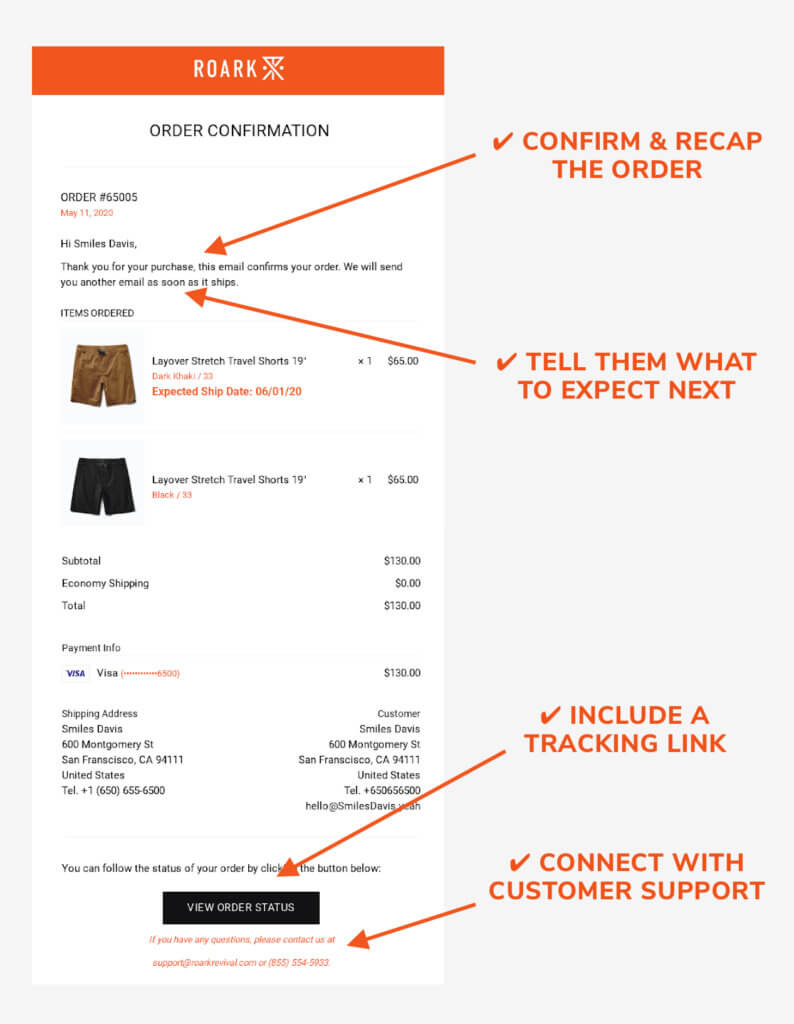
They don’t use this email to upsell or cross-sell, and that’s fine.
If upselling is something you want to explore, though, here’s how to do it:
On episode five of the Drive and Convert podcast, our CEO Jon MacDonald tells a great email confirmation story. He had just purchased a set of lights. On the thank you page, they asked if he wanted to add more. At the time, he didn’t. But when he received the order confirmation email, it reminded him, “hey, if you change your mind, you have four hours from when this email is sent to add a few more before we’re going to start packing up your order.” It gave him the option to, “Click here to add four more, eight more or twelve more.”
When Jon chose four, he was whisked to his cart with an order number, new total, and no extra shipping (a nice incentive!).
Ritual does something similar for existing subscription customers. The email below was sent to a customer already stocked up on women’s vitamins. Instead of pitching more women’s vitamins, Ritual sent a “next-of-kin” offer on men’s vitamins.

You can also use the confirmation email to pitch a subscription. Fullscript does this with a friendly and unobtrusive reminder:

Also worth noting: compared to the “subscribe and save” model many brands default to, Fullscript pitches convenience instead of price as the main incentive.
#2 – Shipping Confirmation
The second email your customer receives post-purchase is shipping confirmation. It notifies the customer their order is on its merry way.
When to send it: Right when the item ships.
How to think about it: This email builds on the customer experience you provided in your first email. You’re continuing to alleviate anxiety (“we didn’t steal your money!”), deliver assurance, and build trust. You’re paving the way for the great review you’ll request a few emails down the road.
How to do it: Make sure and include these pieces of information in your shipping confirmation:
- Shipping update: answer “what’s happening with my package?”
- Expected delivery date/date range
- Tracking information: even if the tracking number isn’t available for the shipping carrier (it may take 12-24 hours for those to show up), you can simply say, “Hey, fyi, this link may not show results for x amount of time” the way Food52 does below. In addition to reassuring the customer, this one line may reduce how many support requests you get. When Taster’s Club, an alcohol subscription box, added this, they cut customer support volume by 10%.

- Additional resources
What kind of additional resources?
Anything that helps your customer engage with and use the product you’re sending. Remember, if the product sits unopened in the box or stuffed onto a dusty closet shelf, you and the customer are both missing out on a lot of value. So, give your customer everything they need to experience the “Aha! This is amazing!” moment where they fall in love with your product.
Not only does this help your customer, it also paves the road for a great review or referral down the road.
For example, check out how Biolite includes an instructional video, three quick tips to get going once the light arrives (bonus points for skimmable text), and a link to FAQ. All of these serve the customer’s interests and goals — now, when they get the product, they can immediately start using it.

#3 – We’re here for you. Need anything from us?
Once your product hits the doorstep, it’s time to check in that everything arrived a-okay and assure the customer you’re available if not.
When to send it: The day the product arrives or 2-3 days after it arrived.
How to think about it: We’ve all had a package show up that looks as if it were a stand-in ball for some midday warehouse soccer. This email is to double-check that didn’t happen. You want to ask questions like “did you receive your order?” and “was everything okay?”
When you do this, you’re preemptively handling a bad situation and heading off a negative review. If something did go wrong during shipment, you’re saying “hey, if you’re not 100% satisfied, reply to this and we’ll fix it.” When the customer has this email, they’re more likely to hit reply than vent on social media.
Plus, when a customer engages with you this way, you have an opportunity to take advantage of the service recovery paradox. This occurs when a customer is happier and more loyal to a brand after the company fixes a problem…compared to if the customer never had a problem at all! So keep in mind when you turn a bad situation into a good one you’re pre-selling a good review and future purchases.
By the way, this is a great opportunity to take advantage of the service recovery paradox.
How to do it:
- Ask how things are going: Was it on time? In good shape? Did they have any issues?
- Offer support: show how easily customers can reach out if there’s a problem. The email below from Outdoor Voices is a great example of this. It comes directly from a customer experience team member (“Chelsey”) and states that if the customer wants personal attention, all they have to do is reply.

- Provide multiple ways to get in touch: A “Hit reply to this email” note can be effective, but we’ve found adding a support phone number can build more trust, especially if your demographic skews 45-50+. If your demographic is younger, you could alternatively lean into live chat, SMS, or social media support options.
- Additional resources: Consider showing customers how to use the product or addressing FAQs. Get your customer support team involved here and use data or observations to figure out what kind of information is most relevant to customers. This, again, can help reduce support volume.
For example, Allergy Buyers Club sends a friendly email check-in with simple setup instructions, just in case customers haven’t set up the product yet:

#4 – How about a review?
Once you deliver an incredible product and/or provide stellar customer service, now’s the time to ask for a customer review. The trick? Make it as easy as possible for the customer to do this.
When to send it: A week or so after they’ve received the product.
How to think about it: According to data gathered by Spiegel Research Center, nearly 95 percent of shoppers read online reviews before making a purchase.
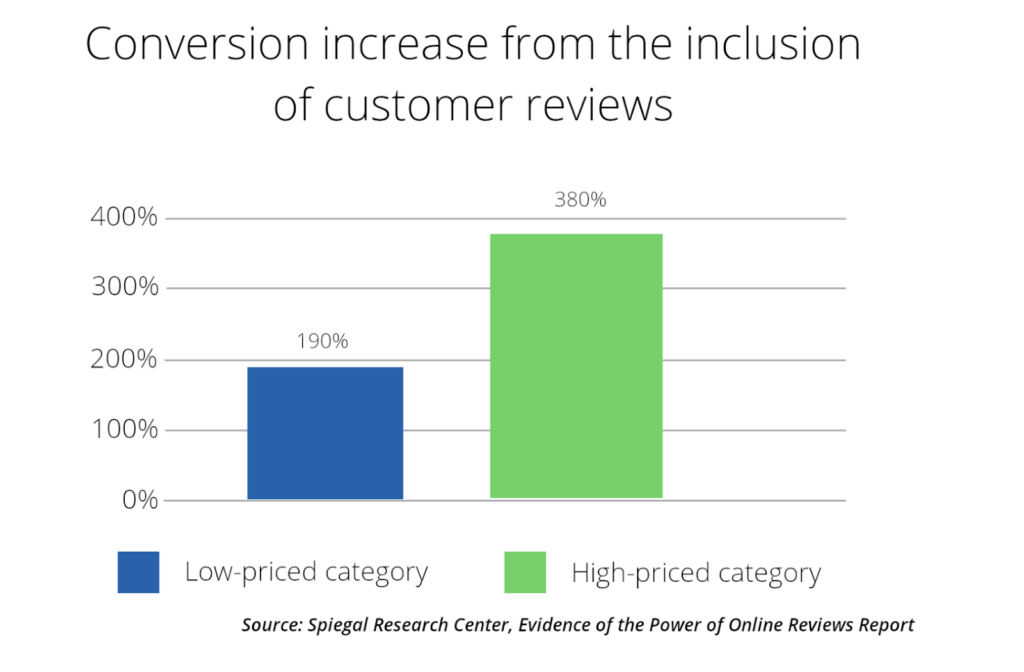
Gathering post-purchase reviews will help you improve conversion rates for new customers down the road.
We reached out to DJ Sprague, the Chief Marketing Officer at Trust Brands, for his opinion on why verified product reviews are such a powerful motivator for potential customers. Here is what he had to say…
“Social proof is pivotal at the critical moment when shoppers ask themselves these common questions before making a final purchase decision:
- Who else has purchased this?
- How popular is this product?
- How do I know that I can trust this product or brand?
Without trustworthy evidence or social proof to adequately satisfy these uncertainties, they are less likely to convert in the first place, let alone continue to purchase or recommend it to others in the future.”
What’s more, a pile of positive reviews is a gold star for SEO. Yotpo looked at 30,000 businesses and compared their organic traffic before and after posting reviews. For a number of reasons, posting those reviews made a big impact:
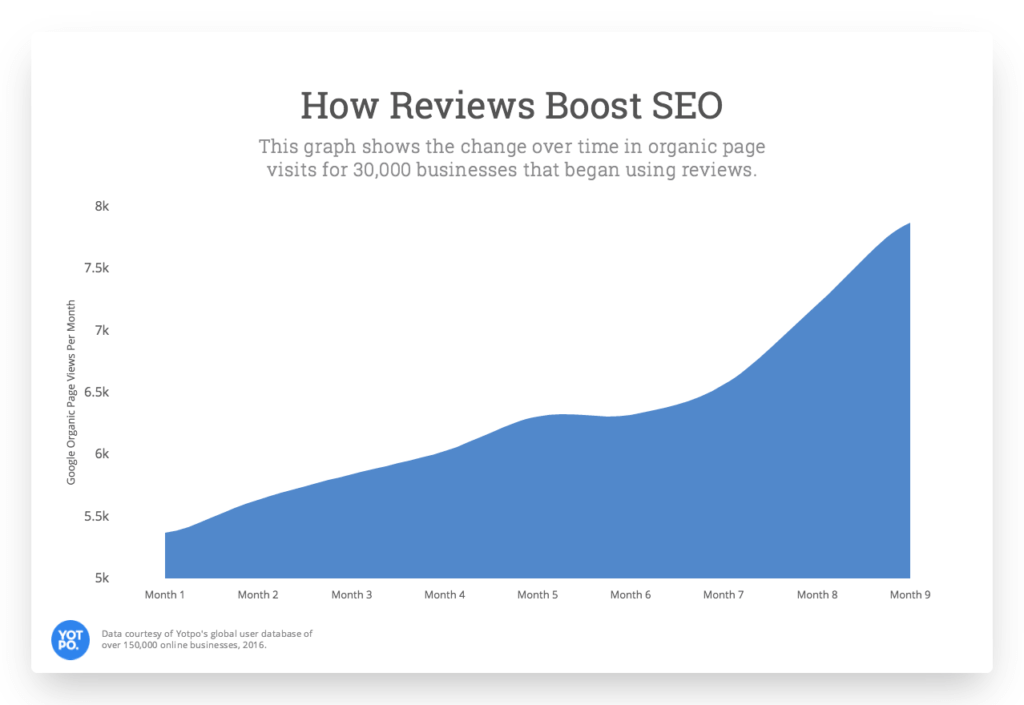
And if you need even more convincing, consider this: reviews are an excellent way to hear, straight from your customers, what they love, hate, and can’t live without. In other words, it’s a feedback goldmine.
How to do it: Of course, you can’t send any old email and cross your fingers for a great review. Ideally, you’ve laid the groundwork for this in your product and your last three excellent emails. To further incentivize customers, include the following in this email:
- A brief reminder what a great product or experience they just had
- A clear explanation of how long the survey/review will take
- Link to the exact page they need to enter the review. Make this as easy as you possibly can. Tools like Shopper Approved ensure all the customer has to do is select a number of stars. For example, see the email from Target below. They make the review easy and encourage action by framing the review as a way to help others (which is true, not manipulative, since most shoppers read them!):

- Insightful prompts. If you’re going beyond stars and asking for an in-depth review, lead with some good questions.
What counts as a good question? Here are a few options:
- What was the customer’s life/situation like before purchasing your product or service?
- What did the product or service do for the reviewer?
- What happened as a result?
- What would the reviewer say to someone considering a similar purchase?
A note on validity:
Prompting customers for reviews via email helps ensure you collect reviews from verified purchasers. There are plenty of product detail pages where any visitor can leave a review. These are untrustworthy because anyone — family, friend, employees, random person — can add their thoughts. In contrast, when you only request reviews as a part of the post-purchase experience sequence, you ensure all of your reviews are from verified customers.
As you collect these reviews, though, keep in you want to use an approved review aggregator. There are plenty of plugins that will collect reviews on your site, but not all of them are approved, and not all of them build search engine trust. Choose one that is for better optimization.
Also keep in mind that you don’t want to stop asking for reviews once you get 50, 100, or even 200. Bright Local found 84% of consumers think reviews older than 3 months aren’t relevant anymore, so keep asking for fresh ones.
#5 – Refer a friend
Something that continually surprises us is how few brands ask for referrals. What a missed opportunity! There are a few ways you can do this in context of the other emails your sending:
- Conditional referral ask: only send a referral request to customers who submitted a product review or vice versa
- Ask for a referral instead of review
- Ask a segment of purchasers for a referral (e.g. (25% receive a referral request, 75% receive a review request)
Whichever option best fits your goals, referrals ask customers to talk with their friends and family and send them your way.
When to send it: A week or so after they’ve received your product or a few days after you asked for a review.
How to think about it: If you’re not considering the different ways you can help a happy customer become a referral source, you’re leaving some revenue on the table. The first step here is surprisingly simple, too. You ask. Many brands immediately jump to “10% off for you and friend” or something similar. But remember, there are better options than offering a straight discount.
How to do it:
- Prompt a share: offer the customer something worth sharing. The generic “I just bought this product, you should too!” social media post is cheesy and pushy (not to mention off-brand for most companies). It’s also a mistake because most customers don’t want to associate with this message. But when you provide something more useful, such as a how-to video or recipes paired it with a referral code, sharing that kind of helpful content comes more naturally for your customers.
- Give it a personal touch: Similar to the idea above, swap out the cheesy share script for something more thoughtful and personalized. For example, “Good news! Someone out there loves you because they took the time to forward you this video. Here’s a little bit about what we do…”
- Offer a creative incentive: While 10% off or $10 for you + $10 for a friend referral offers are common, they’re not your only (or your best) option. Consider alternative perks like free shipping or a free gift. For example, Bombas incentivizes referrals with free socks. And who doesn’t want more socks?
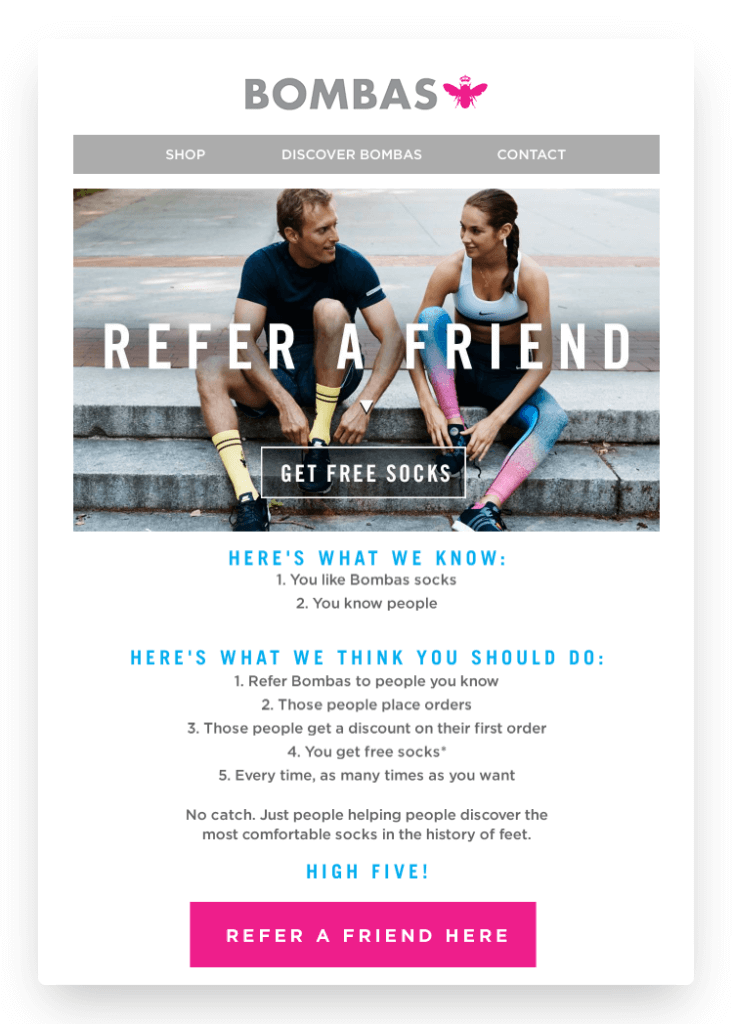
And while we’re calling this a referral email, you could use it to pitch a loyalty program instead. If you need a tool for all this, check out Smile.io. They do a great job of helping you manage loyalty programs and referral incentives.
#6 – Add the customer to your usual email marketing
Whew, you’ve done some hard — and good — post-purchase email work. There’s just one more send you want to be aware of. When, and only when, your customer has completed all the emails above, you can add them to regular-ish marketing emails.
When to send it: After the customer has received all other post-purchase emails.
How to think about it: While it’s true you’re adding the customer to regular marketing emails here, you don’t want to put them on the same cadence as non-customers. Have at least one separate segment for existing customers. Put them on either a slower cadence or only send them high-priority marketing messages (e.g. holidays).
You’ve earned some of the customer’s trust by this point, but you want to keep in the mind it’s still fragile. Remember the adage, “trust takes years to build, seconds to break, and forever to repair.” Keeping building trust through regular emails.
How to do it:
- Use a tool like Klaviyo to hold all regular marketing emails until customers have completed the post-purchase flow.
- Use a unique tag, segment, or list to identify existing customers in your email platform.
- Demonstrate value in slow drip emails
Think about it this way: you talk and share information with a friend very differently than you do with a stranger. You’re not sure what a stranger thinks of you; you’re reasonably sure a friend likes you. A customer is more like a friend than a stranger. You’ve earned their affection, and now you can engage with them in a more personal way.
So, instead of bombarding them with additional purchase options and promos, hone in on helpful and personalized emails.
Check out how Ritual does this for existing customers. By showcasing value in slow drip emails, they continue building customer “friendship” (trust and affection) which improves their retention:
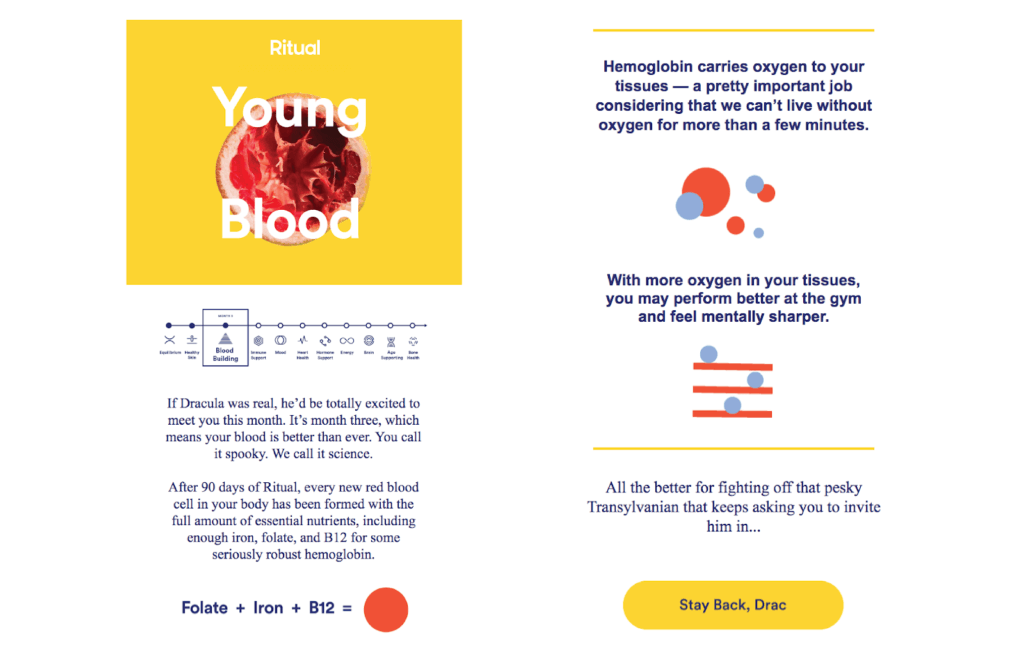
One last thing before we wrap up the email journey here: There are a few things you want to keep in mind for every email you send. These are best practice items that ensure your email is readable, enjoyable, and working as hard as it can for you and customers.
Bonus: best practice checklist for EVERY post-purchase email
Keep in mind, most customers (like you) have roughly 397 unread promotions in their inbox. The fact is, they haven’t been sitting around waiting for your communication. More likely, they’re in their inbox because they’re procrastinating, trying to feel productive, or searching for something.
This means you don’t have long to grab their attention. Follow the checklist below to give your emails a better chance of earning the customer’s attention.
- Skimmable: Long blocks of text are intimidating. Say only what you need to say, and even break that up into short paragraphs and bullet points. Don’t make the customer squint at their screen to figure out where you’re saying to them.
- Focused on THEM: Lead with what matters most to the customer (Reassurance? Tracking information?) or something that’s valuable to them.
- Delightful: Think of the last transactional email you bookmarked or, for that matter, actually remember. I’ll bet it probably delighted you in some way. The best emails do. Find a way to deliver joy, surprise, or connection through your emails. Your customers are more likely to remember them (and your brand) if you do.
- Inbox friendly: Not everyone uses whatever email app is on your phone. Use a tool like Litmus to preview emails in different devices and email providers to ensure your emails look the way they’re supposed to. And use a tool like mail tester to ensure your emails reach the customer’s inbox.
- True to brand: Don’t use the stock designs or imagery that comes with your email or marketing software. Customize each email with your colors, font, and logo. Make sure the tone and voice you use with customers is consistent, too. Your website, emails, and campaigns should all sound like “you.”
- Purposeful: If you don’t know why you’re sending an email, trust me, your customers won’t either. Have one clear and defined purpose for every post-purchase email.
Alright, that wraps up the nitty-gritty of post-purchase emails. To finish out this journey, let’s zoom back out and make sure we’re on the same page in terms of what you want to track throughout all these optimizations.
Tracking improvements in the post-purchase experience: Four metrics you can impact
Done well, optimizing your customer’s post-purchase experience with your brand is going to boost four important metrics:
- Customer Lifetime Value: If you’re optimizing your post-purchase experience — from the thank you page to emails — you’ll see an increase in customer lifetime value (LTV). LTV is the average cumulative total of a customer’s purchases. So, if you’re doing a great job satisfying customers and encouraging them to purchase again, those repeat purchases will drive up LTV.
- Healthy Traffic Sources: If you’re incentivizing repeat purchases, you’ll most likely see traffic categories such as Direct, Email, or Referral account for bigger shares of your overall traffic. As in, when you view a pie chart of these in Google Analytics, those channels will make up larger slices than before. This is a good thing because you have more control over these channels than Organic (SEO) or Paid Advertising (Facebook/Google). And more balance in your referral channels is an indicator of a healthy, secure business.
- Verified Product Reviews (& Average Rating): In most cases, people only leave a review if they’re satisfied or deeply unsatisfied. You see few reviews between one and four stars because most customers don’t care about that mushy middle — at least, not enough to take time out of their day to mention it. If you’re providing a great product with great support and asking for reviews post-purchase, you’re going to gather more verified and high-rated reviews.
- Conversion Rate: Thanks to repeat purchases and those verified high reviews, your overall conversion rate should increase as well. Repeat purchases mean easier and more frequent sales, both of which positively impact your conversion rate.
Now, with improvements like these, it may be tempting to pull back on traditional conversion rate optimization efforts and focus on post-purchase experience instead. But not so fast. You need both of these for healthy conversions, revenue, and margin.
How pre-purchase and post-purchase optimizations work hand-in-hand
Work your way up to these post-purchase experience steps and start seeing digital experience optimization as something that spans the entire customer experience, from the moment they meet you to their 2nd, 5th, and 50th purchase.
If you haven’t done any optimization yet, the best place to start is pre-purchase. You want to go to “optimization college”, so to speak, and complete your basic courses on helping the customer get to the point of purchase. Focus first on providing a great customer experience that maximizes the number of visitors who convert into first-time customers.
Then, once you’ve graduated, you can move on to graduate school — post-purchase optimization. With the opportunities to increase average order value, encourage repeat purchases, and improve customer retention, this part of the customer journey is well worth your attention.
Eventually, you’ll want to have a comprehensive optimization program, which analyzes the end-to-end purchasing process and identifies ways you can continue maximizing the value of every customer experience.
If you’re already there, consider researching our Digital Experience Optimization Program™, which is a custom program that systematically improves your user experience over time.

About the Author
Laura Bosco
Laura Bosco is a former Content Marketer at The Good and freelance writer. She helps translate thoughts, opinions, and client experiences into written products that are both entertaining and educational.